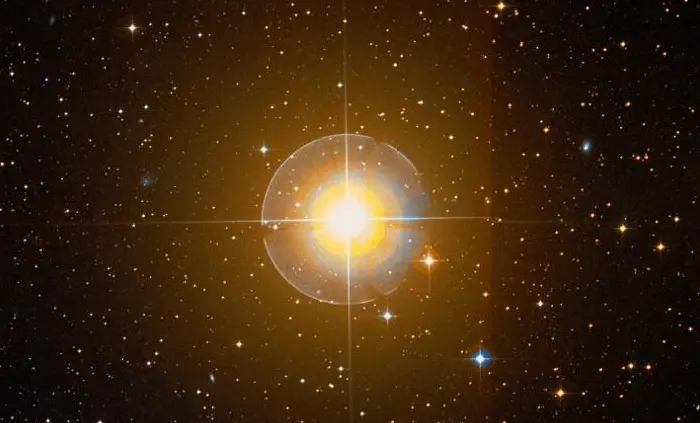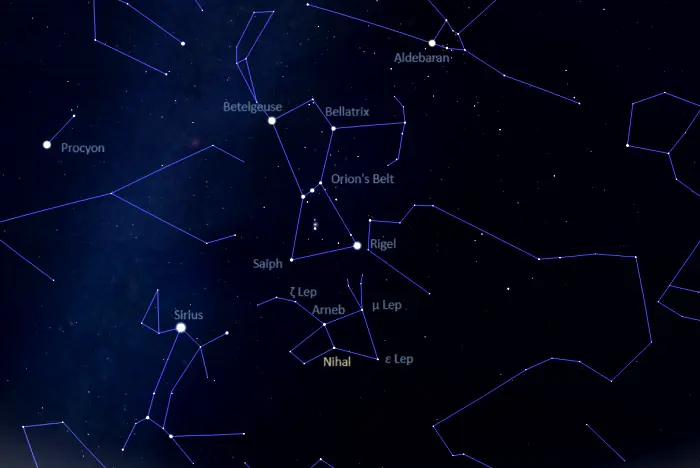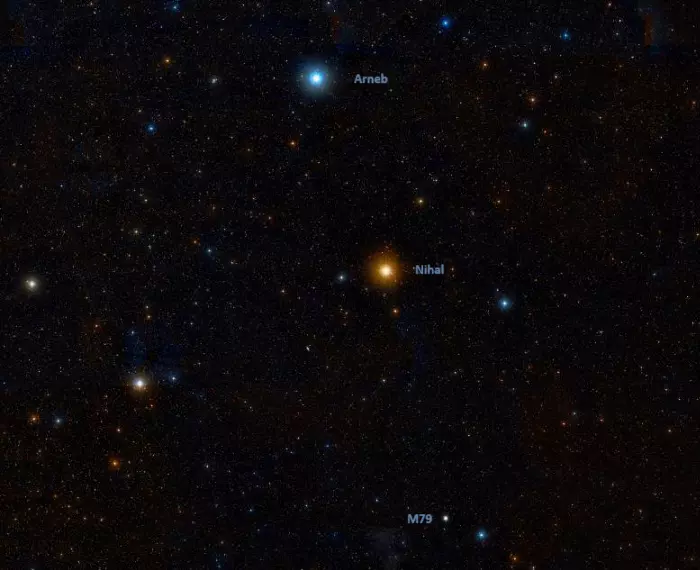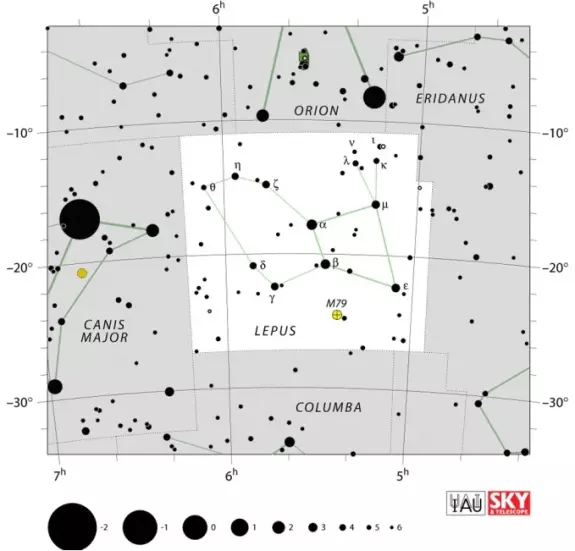Nihal, Beta Leporis (β Lep), is a yellow bright giant star located approximately 160 light-years away in the constellation Lepus, the Hare. With an apparent magnitude of 2.84, it is the second brightest star in Lepus, after Arneb (Alpha Leporis). It may form a binary system with a fainter companion.
Star system
Nihal is a bright giant of the spectral type G5 II. It has 3.5 times the Sun’s mass and a radius of 16 solar radii. With an effective temperature of 5,450 K, it shines with 171 solar luminosities. The giant star spins at 11 km/s. It has an estimated age of 240 million years.
Nihal has a companion at a separation of 2.58 arcseconds. The two stars may form a binary system or they may just be optical companions.
Beta Leporis B is a suspected variable star. It is catalogued as NSV 2008. It has the stellar classification K1V, indicating an orange dwarf. At maximum brightness, it shines at magnitude 7 and is invisible to the unaided eye.

Nihal (Beta Leporis), image: Wikisky
Facts
In old Arabic astronomy, Nihal was part of an asterism called the Throne of Jauza or the Throne of Jawza. The asterism was also known as Al Kursiyy al Jabbar or Al ‘Arsh al Jauzah, meaning “the chair of the giant” or “the chair of the central one.”
The central one, Jawza, was an unknown female figure from an old Arabian legend. It was represented by what is now the constellation Orion. The Throne of Jawza was formed by Nihal with Arneb, Gamma and Delta Leporis.
Name
The name Nihal (pronunciation: /ˈnaɪ.æl/) comes from the Arabic al-nihal, meaning “quenching their thirst.” It was sometimes also spelled Nibal.
The name is a reference to an old Arabian asterism known as Camels Quenching Their Thirst. The star pattern was formed by Arneb (Alpha Leporis), Nihal (Beta Leporis), Gamma and Delta Leporis.
The name Nihal was approved by the International Astronomical Union’s (IAU) Working Group on Star Names (WGSN) on July 20, 2016. It formally applies only to the primary component, Beta Leporis A.
In Chinese astronomy, Nihal was known as 廁二 (Cè èr), the Second Star of Toilet. It formed the Toilet asterism with Arneb (Alpha Leporis), Gamma and Delta Leporis. The asterism was part of the Three Stars mansion, which represented the body of the White Tiger.
Location
Nihal is easy to identify because it lies just south of the bright, familiar constellation figure of Orion. It is the second brightest star in the quadrilateral asterism that outlines the body of the celestial Hare. It appears just below the slightly brighter Arneb (Alpha Leporis).

Nihal location, image: Stellarium
The two stars can be used to find the bright globular cluster Messier 79, the only Messier object in Lepus. A line drawn from Arneb through Nihal leads to the cluster. M79 has an apparent magnitude of 7.7 and lies 42,000 light-years away. It can be observed in binoculars and small telescopes.

Arneb, Nihal and Messier 79, image: Wikisky
Constellation
Nihal is located in the constellation Lepus. Lepus is one of the 48 ancient constellations catalogued by the Greek astronomer Ptolemy in his Almagest in the 2nd century CE. Unlike most Greek constellations, it is not associated with any specific figure in Greek mythology. It represents a hare chased by Orion and his two dogs (Canis Major and Canis Minor).
Lepus occupies an area of 290 square degrees just south of the celestial equator. It is the 51st largest constellation in the sky. Its two brightest stars – Arneb and Nihal – shine at third magnitude. Arneb is a yellow-white supergiant located approximately 2,200 light-years away. With a mass of 14 solar masses, the star is a supernova candidate.
Other notable stars in Lepus include the orange giant Epsilon Leporis, the orange giant or subgiant Delta Leporis, the Mira variables R Leporis (Hind’s Crimson Star) and T Leporis, the blue subgiant Mu Leporis, the semi-regular pulsating red giant RX Leporis, and the symbiotic binary system SS Leporis.

Lepus constellation map by IAU and Sky&Telescope magazine
In addition to Messier 79, deep sky objects in Lepus include the lenticular galaxies NGC 1979 and NGC 1993, the irregular galaxy NGC 1821, the barred spiral galaxy NGC 1964, and the Spirograph Nebula (IC 418), a planetary nebula located 3,600 light-years away.
The best time of the year to see the stars and deep sky objects in Lepus is during the month of January, when the constellation appears higher in the sky in the early evening. The entire constellation is visible from locations south of the latitude 63° N.
The 10 brightest stars in Lepus are Arneb (Alpha Lep, mag. 2.589), Nihal (Beta Lep, mag. 2.84), Epsilon Leporis (mag. 3.166), Mu Leporis (mag. 3.259), Zeta Leporis (mag. 3.524), Gamma Leporis (mag. 3.587), Eta Leporis (mag. 3.72), Delta Leporis (mag. 3.85), Lambda Leporis (mag. 4.286), and Kappa Leporis (mag. 4.43).
Nihal – Beta Leporis
| Spectral class | G5 II |
| U-B colour index | +0.47 |
| B-V colour index | +0.82 |
| R-I colour index | +0.44 |
| Apparent magnitude | 2.84 |
| Absolute magnitude | −0.65 |
| Distance | 160 ± 1 light-years (49.2 ± 0.4 parsecs) |
| Parallax | 20.8697 ± 0.2047 mas |
| Radial velocity | -14.20 ± 0.1 km/s |
| Proper motion | RA: -5.748 ± 0.144 mas/yr |
| Dec.: -83.650 ± 0.151 mas/yr | |
| Mass | 3.5 ± 0.1 M☉ |
| Luminosity | 171 L☉ |
| Radius | 16 R☉ |
| Temperature | 5,450 ± 100 K |
| Metallicity | +0.05 dex |
| Age | 240 million years |
| Rotational velocity | 11 km/s |
| Surface gravity | 2.60 ± 0.03 cgs |
| Constellation | Lepus |
| Right ascension | 05h 28m 14.7228880318s |
| Declination | −20° 45′ 33.997988694″ |
| Names and designations | Nihal, Beta Leporis, β Lep, 9 Leporis, HD 36079, HR 1829, HIP 25606, SAO 170457, PPM 248938, FK5 204, GC 6762, GCRV 3303, BD−20 1096, NSV 2008, PLX 1246, RAFGL 756, IRAS 05261-2047, 2MASS J05281473-2045338, UBV 5252, TYC 5928-1657-1, Gaia DR2 2968097043227107968, Gaia DR3 2968097043228517120, AAVSO 0524-20, ADS 4066 A, CCDM J05283-2046A, IDS 05240-2050 A, WDS 05282-2046A |